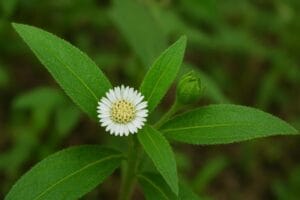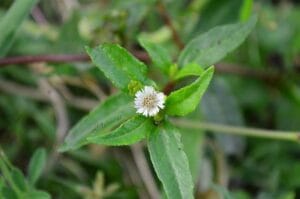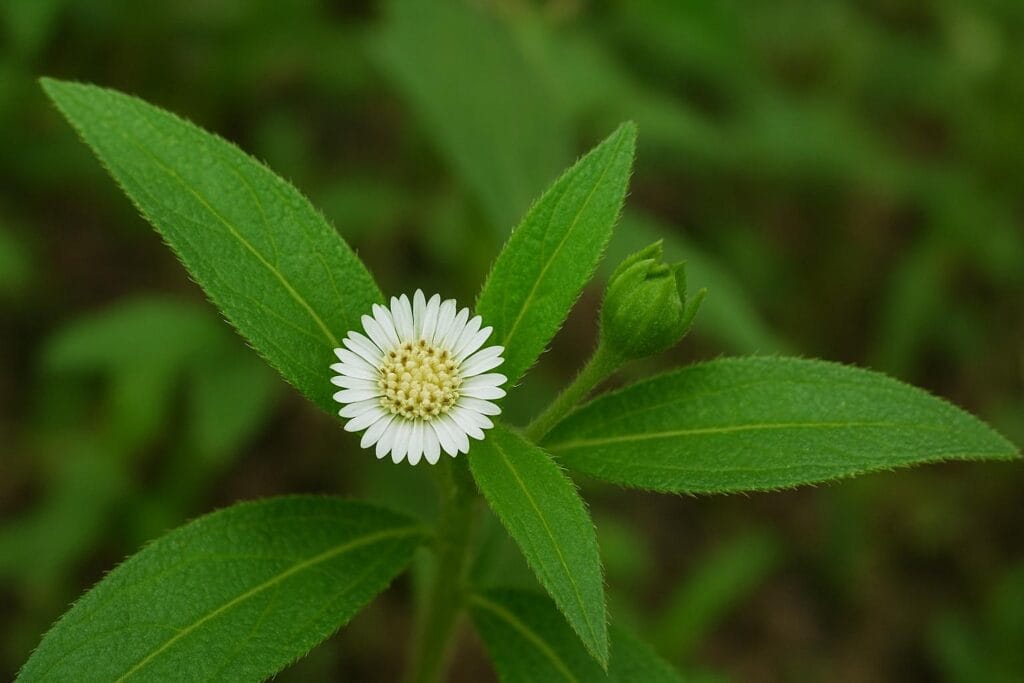Bhringraj is often called the Herbal King because of its powerful benefits for hair and overall wellness. People across India and other parts of Asia have trusted this medicinal herb for centuries. In Ayurveda Bhringraj is known as Eclipta prostrata or Eclipta alba and is believed to promote strong hair growth, improve scalp health and support liver function. Despite its fame many people still struggle to correctly identify the true Bhringraj plant because it looks similar to other common weeds. This comprehensive guide will help you learn exactly how to identify Bhringraj in its natural habitat, allowing you to avoid confusion and benefit from its rich healing properties.

What is Bhringraj
Bhringraj is a member of the Asteraceae family, which includes sunflowers. The plant is a creeping herb that grows in damp areas like fields, ponds, and rivers. Rarely does this short, seasonal herb reach a height of more than one meter. Bhringraj is described as cooling, bitter, and rejuvenating in Ayurveda. Its roots, leaves, and flowers are all used in herbal remedies, particularly in skin care products, liver tonics, and hair oils. Once you know its distinguishing characteristics, Bhringraj is easy to locate because it grows widely in semi-tropical and rural areas.
Why Bhringraj Identification Matters
Correct identification of the Bhringraj plant is extremely important because several look alike plants exist in the same environments. Many of these weeds do not have the same medicinal value as Bhringraj. Using the wrong plant may not provide the health benefits you expect and could even lead to side effects. For people who want to prepare their own herbal remedies or collect fresh leaves knowing the right plant ensures safety and effectiveness. Herbal practitioners farmers and natural health enthusiasts can all benefit from clear identification tips.
Physical Characteristics of Bhringraj
Plant Size and Shape
Bhringraj is a small creeping plant that grows close to the ground. It usually spreads out rather than growing upright. The average height of Bhringraj is between ten and fifty centimeters. The stems are soft green and covered with fine white hair.
Leaves
The leaves of Bhringraj are opposite which means they grow in pairs facing each other on the stem. Each leaf is narrow long and shaped like a lance. The texture is rough to touch and tiny hairs can be seen on the surface. The color of the leaves is dark green which makes them stand out in wet soil or grassy areas. When crushed the leaves give out a strong earthy smell.

Flowers
One of the most reliable ways to identify Bhringraj is by its flowers. The flowers are small round and white. They grow singly at the end of stems. Unlike big colorful flowers of other herbs Bhringraj flowers are plain and simple but they are very useful for correct identification.
Seeds
The seeds of Bhringraj are flat elongated and brown. They usually mature during late summer and are spread easily by wind or water. Because the plant produces plenty of seeds it grows abundantly in the right conditions.
Roots
The roots of Bhringraj are thin shallow and fibrous. They do not go very deep into the soil which is why the plant grows best in moist loose soil near water sources.
Habitat and Growing Conditions
Bhringraj prefers wet and fertile soil. You will often find it near rivers ponds and ditches. It thrives in tropical and subtropical climates where there is plenty of rainfall. The plant grows during the rainy season and continues until early winter. In rural areas it often grows wild in paddy fields and open grassy lands. People who want to cultivate Bhringraj at home should keep the soil moist and place the plant in partial sunlight.
Differences Between Bhringraj and Look Alike Plants
There are a few weeds that resemble Bhringraj. The most common are false daisy species and some small sunflower family herbs. To avoid confusion remember the following differences
- Bhringraj flowers are always small round and white while many look alike plants have yellow flowers
- The leaves of Bhringraj are rough hairy and placed opposite each other whereas similar plants may have smoother or alternate leaves
- Bhringraj creeps low to the ground but some weeds grow more upright
By keeping these points in mind you can separate the true Herbal King from ordinary weeds.

Traditional Methods of Identifying Bhringraj
In villages traditional healers often identify Bhringraj by taste smell and appearance. The leaf is bitter when chewed which is a natural sign of its medicinal strength. Crushing the leaves gives a distinct earthy fragrance. Experienced practitioners also observe the habitat since Bhringraj always prefers moist areas. These traditional methods when combined with botanical knowledge make identification accurate and reliable.
Bhringraj in Ayurveda
Ayurveda describes Bhringraj as a Rasayana herb which means it rejuvenates and promotes longevity. The Sanskrit texts refer to it as Kesharaj meaning King of Hair. Bhringraj oil prepared by boiling the leaves in sesame or coconut oil is a famous remedy for hair loss premature greying and scalp infections. In addition Bhringraj juice is used to support liver function improve digestion and purify the blood. The plant is also used for treating skin conditions and calming the mind.
Benefits of Using Correctly Identified Bhringraj
Once you are sure you have identified the correct plant you can enjoy its many health benefits. Some of the proven advantages include
- Promoting thick and strong hair growth
- Preventing hair fall and premature greying
- Supporting liver health and detoxification
- Improving skin texture and healing minor wounds
- Enhancing sleep and reducing stress
Each of these benefits depends on using the right plant which highlights why proper identification is so essential.
Step by Step Guide to Identifying Bhringraj
- Look for a low growing creeping plant in moist soil
- Check if the stems are soft green and hairy
- Observe the leaves to ensure they are opposite lance shaped rough and dark green
- Examine the flowers to confirm they are small white and round
- Rub the leaves gently to check for the earthy smell
- Verify the habitat since Bhringraj grows best near water sources
Following these steps will give you confidence in recognizing the true Bhringraj plant.
Harvesting and Storing Bhringraj
Once identified you can harvest Bhringraj during the rainy season when the plant is at its peak. Cut the stems and leaves carefully without uprooting the plant completely so it can regrow. After harvesting wash the leaves and dry them in shade. Once dry store them in an airtight container to preserve their medicinal value. For oil preparation use fresh leaves directly as they contain more juice and nutrients.
Precautions to Take
Even though Bhringraj is safe for most people it is important to use it wisely. Always confirm the plant identity before using. Pregnant women nursing mothers and people with chronic conditions should consult a healthcare professional before taking herbal remedies. If you experience any unusual reaction stop use immediately.
Modern Research on Bhringraj
Recent scientific studies have confirmed many traditional uses of Bhringraj. Researchers have found that the plant contains bioactive compounds like wedelolactone and ecliptine which support liver function and hair growth. Laboratory tests show that extracts of Bhringraj promote new hair follicle development and protect the liver from toxins. These findings add credibility to the ancient Ayurvedic knowledge.
Cultivating Bhringraj at Home
Many people now prefer to grow their own Bhringraj for easy access to fresh herbs. The process is simple
- Select moist fertile soil
- Plant seeds or cuttings during the rainy season
- Keep the soil damp and avoid direct harsh sunlight
- Harvest leaves regularly to encourage growth
Home cultivation ensures a pure supply of Bhringraj free from chemical sprays or contamination.
The Global Popularity of Bhringraj
Today Bhringraj is gaining popularity outside India as well. Herbal companies in Europe America and Asia are selling Bhringraj based oils capsules and powders. The growing interest in natural remedies has made this humble weed an international star. However authentic identification remains crucial so that consumers receive genuine benefits.
Final Thoughts
Bhringraj truly deserves its title as the Herbal King. From thickening hair to supporting liver health its benefits are countless. But these benefits are possible only if you can correctly identify the plant. By learning the physical features such as small white flowers opposite rough leaves creeping growth and preference for moist habitats you can confidently recognize Bhringraj in nature. With this knowledge you can harvest prepare and use the plant safely. As more people turn to natural healing the ability to identify Bhringraj will continue to hold great value.

